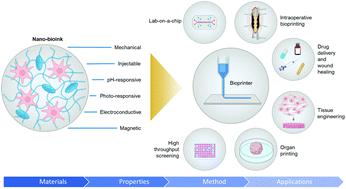当前位置:
X-MOL 学术
›
Biomater. Sci.
›
论文详情
Our official English website, www.x-mol.net, welcomes your feedback! (Note: you will need to create a separate account there.)
Exploiting the role of nanoparticles for use in hydrogel-based bioprinting applications: concept, design, and recent advances
Biomaterials Science ( IF 6.6 ) Pub Date : 2021-07-28 , DOI: 10.1039/d1bm00605c Aishik Chakraborty 1 , Avinava Roy 2 , Shruthi Polla Ravi 3 , Arghya Paul 4
Biomaterials Science ( IF 6.6 ) Pub Date : 2021-07-28 , DOI: 10.1039/d1bm00605c Aishik Chakraborty 1 , Avinava Roy 2 , Shruthi Polla Ravi 3 , Arghya Paul 4
Affiliation

|
Three-dimensional (3D) bioprinting is an emerging tissue engineering approach that aims to develop cell or biomolecule-laden, complex polymeric scaffolds with high precision, using hydrogel-based “bioinks”. Hydrogels are water-swollen, highly crosslinked polymer networks that are soft, quasi-solid, and can support and protect biological materials. However, traditional hydrogels have weak mechanical properties and cannot retain complex structures. They must be reinforced with physical and chemical manipulations to produce a mechanically resilient bioink. Over the past few years, we have witnessed an increased use of nanoparticles and biological moiety-functionalized nanoparticles to fabricate new bioinks. Nanoparticles of varied size, shape, and surface chemistries can provide a unique solution to this problem primarily because of three reasons: (a) nanoparticles can mechanically reinforce hydrogels through physical and chemical interactions. This can favorably influence the bioink's 3D printability and structural integrity by modulating its rheological, biomechanical, and biochemical properties, allowing greater flexibility to print a wide range of structures; (b) nanoparticles can introduce new bio-functionalities to the hydrogels, which is a key metric of a bioink's performance, influencing both cell–material and cell–cell interactions within the hydrogel; (c) nanoparticles can impart “smart” features to the bioink, making the tissue constructs responsive to external stimuli. Responsiveness of the hydrogel to magnetic field, electric field, pH changes, and near-infrared light can be made possible by the incorporation of nanoparticles. Additionally, bioink polymeric networks with nanoparticles can undergo advanced chemical crosslinking, allowing greater flexibility to print structures with varied biomechanical properties. Taken together, the unique properties of various nanoparticles can help bioprint intricate constructs, bringing the process one step closer to complex tissue structure and organ printing. In this review, we explore the design principles and multifunctional properties of various nanomaterials and nanocomposite hydrogels for potential, primarily extrusion-based bioprinting applications. We illustrate the significance of biocompatibility of the designed nanocomposite hydrogel-based bioink for clinical translation and discuss the different parameters that affect cell fate after cell-nanomaterial interaction. Finally, we critically assess the current challenges of nanoengineering bioinks and provide insight into the future directions of potential hydrogel bioinks in the rapidly evolving field of bioprinting.
中文翻译:

利用纳米粒子在基于水凝胶的生物打印应用中的作用:概念、设计和最新进展
三维 (3D) 生物打印是一种新兴的组织工程方法,旨在使用基于水凝胶的“生物墨水”以高精度开发负载细胞或生物分子的复杂聚合物支架。水凝胶是水溶胀的、高度交联的聚合物网络,柔软、准固体,可以支撑和保护生物材料。然而,传统的水凝胶力学性能较弱,不能保留复杂的结构。它们必须通过物理和化学操作来增强,以产生具有机械弹性的生物墨水。在过去的几年里,我们目睹了越来越多地使用纳米颗粒和生物部分功能化的纳米颗粒来制造新的生物墨水。不同大小、形状和表面化学性质的纳米粒子可以为这个问题提供独特的解决方案,主要是因为三个原因:(a) 纳米粒子可以通过物理和化学相互作用机械强化水凝胶。这可以通过调节生物墨水的流变学、生物力学和生化特性来有利地影响生物墨水的 3D 可打印性和结构完整性,从而提高打印各种结构的灵活性;(b) 纳米粒子可以为水凝胶引入新的生物功能,这是生物墨水性能的关键指标,影响水凝胶内的细胞-材料和细胞-细胞相互作用;(c) 纳米粒子可以赋予生物墨水“智能”特征,使组织结构对外部刺激做出反应。通过掺入纳米颗粒,可以使水凝胶对磁场、电场、pH 值变化和近红外光的响应成为可能。此外,带有纳米粒子的 bioink 聚合物网络可以进行高级化学交联,从而可以更大的灵活性来打印具有不同生物力学特性的结构。总之,各种纳米粒子的独特特性可以帮助生物打印复杂的结构,使该过程更接近复杂的组织结构和器官打印。在这篇综述中,我们探索了各种纳米材料和纳米复合水凝胶的设计原理和多功能特性,以用于潜在的,主要是基于挤出的生物打印应用。我们说明了设计的基于纳米复合水凝胶的生物墨水在临床转化中的生物相容性的重要性,并讨论了在细胞-纳米材料相互作用后影响细胞命运的不同参数。最后,
更新日期:2021-08-16
中文翻译:

利用纳米粒子在基于水凝胶的生物打印应用中的作用:概念、设计和最新进展
三维 (3D) 生物打印是一种新兴的组织工程方法,旨在使用基于水凝胶的“生物墨水”以高精度开发负载细胞或生物分子的复杂聚合物支架。水凝胶是水溶胀的、高度交联的聚合物网络,柔软、准固体,可以支撑和保护生物材料。然而,传统的水凝胶力学性能较弱,不能保留复杂的结构。它们必须通过物理和化学操作来增强,以产生具有机械弹性的生物墨水。在过去的几年里,我们目睹了越来越多地使用纳米颗粒和生物部分功能化的纳米颗粒来制造新的生物墨水。不同大小、形状和表面化学性质的纳米粒子可以为这个问题提供独特的解决方案,主要是因为三个原因:(a) 纳米粒子可以通过物理和化学相互作用机械强化水凝胶。这可以通过调节生物墨水的流变学、生物力学和生化特性来有利地影响生物墨水的 3D 可打印性和结构完整性,从而提高打印各种结构的灵活性;(b) 纳米粒子可以为水凝胶引入新的生物功能,这是生物墨水性能的关键指标,影响水凝胶内的细胞-材料和细胞-细胞相互作用;(c) 纳米粒子可以赋予生物墨水“智能”特征,使组织结构对外部刺激做出反应。通过掺入纳米颗粒,可以使水凝胶对磁场、电场、pH 值变化和近红外光的响应成为可能。此外,带有纳米粒子的 bioink 聚合物网络可以进行高级化学交联,从而可以更大的灵活性来打印具有不同生物力学特性的结构。总之,各种纳米粒子的独特特性可以帮助生物打印复杂的结构,使该过程更接近复杂的组织结构和器官打印。在这篇综述中,我们探索了各种纳米材料和纳米复合水凝胶的设计原理和多功能特性,以用于潜在的,主要是基于挤出的生物打印应用。我们说明了设计的基于纳米复合水凝胶的生物墨水在临床转化中的生物相容性的重要性,并讨论了在细胞-纳米材料相互作用后影响细胞命运的不同参数。最后,



























 京公网安备 11010802027423号
京公网安备 11010802027423号